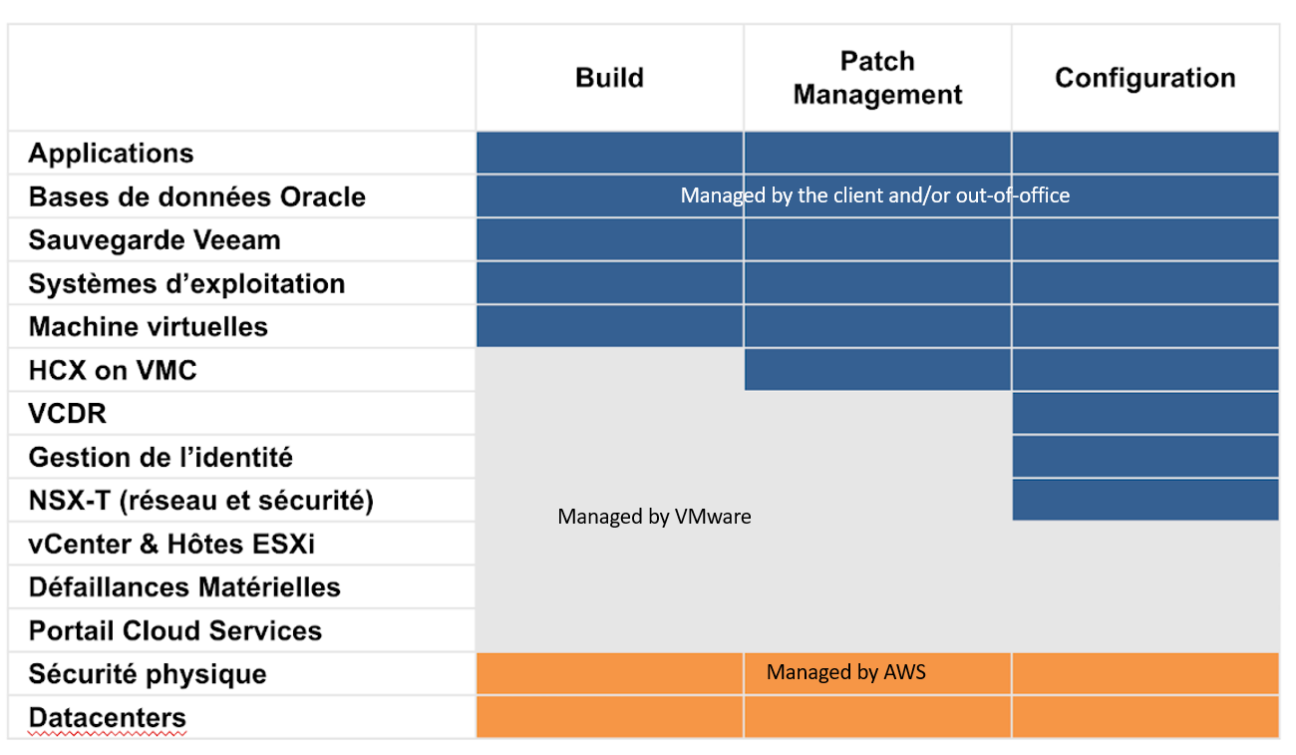Yann Le Clec’h, IT Manager of Synergie gives feedback on migrating to AWS with VMware Cloud
About Synergie
Synergie is an international group (French leader and fifth European group) that offers companies and institutions a global offer of services in the management and development of Human Resources. Its international network consists of 4,600 employees in 17 countries. To implement solutions better adapted to its IT infrastructure needs, the company chose to migrate part of its fleet to the AWS Cloud and VMWare Cloud on AWS. The 6-month migration involved 25 applications and 170 VMs.
A brief introduction to VMWare Cloud
VMware Cloud on AWS provides a dedicated non-multi-tenant cloud infrastructure that supports vSphere clusters of up to 16 hosts hosted on next-generation AWS bare metal infrastructure, based on storage-optimized EC2 instances, and featuring low-latency Non-Volatile Memory Express (NVMe)-based SSDs.
The basic configuration is 2 hosts per SDDC; Cluster capacity can scale up to 16 hosts. VMware Cloud on AWS runs on the VMware Software-Defined Data Center (SDDC) software stack directly on host servers, without nested virtualization.
Creating new VMware SDDC clusters on the AWS Cloud is fast and can be done using a web console or the RESTful API. VMware manages and operates the service, including components of VMware SDDC software. VMware provides scheduled SDDC software updates and urgent software patches with notifications, as well as automatic hardware failure resolution. Below is a macro explaining the shared responsibility model:

Why migrate to AWS? And why to VMWare Cloud?
Synergie used to operate on cycles of 4 to 5 years to reconsider its infrastructures, analyzing the needs for the next 5 years, with a margin including the needs that would be identified later. This approach led to oversized infrastructures at the beginning of the cycle, which often had to be completed at the end of the cycle. The advantage with VMWare Cloud is to have the required capacity for the current period, and to be able to expand it quickly when necessary.
In addition, we had acquired a significant level of skills on VMWare technologies, and we wanted to capitalize on this expertise by choosing VMWare Cloud on AWS. Learning related to the AWS Cloud and IaC is essential and meaningful for Ops teams. The advantage of adopting a VMC solution is to reduce this effort on other teams.
What was the perimeter?
The scope of the migration was 170 VMs spread over 20 ESXi in 2 data centers. These VMs hosted infrastructure components, applications, and a Citrix environment. A client/server application that made requests directly (without cache) on a DB2 database hosted on an IBM Power i (AS/400) had excessively low latencies requirements that did not allow the Citrix farm to be migrated.
The project was initiated in 2021 with:
- a choice of solution approved in March/April,
- project planning before the summer,
- design and construction of infrastructure, security, and network topology from July to October,
- a first POC (Proof of Concept) in October
- and a project that ended in January 2022.
This schedule could have been completed in 5 months without the difficulties related to the client/server application. Indeed, the latency issues (independent of the VMC solution) identified between some x86 and AS400 applications have partially reduced the scope eligible for migration.
What hosting models today?
Synergie now operates applications on 3 models in parallel:
- in its data centers,
- on VMWare Cloud on AWS
- on AWS natively.
The payroll/billing application (RPG/DB2) that remained in the data centers is mastered and the server client application that uses the DB2 database will only evolve to ensure the required level of security but will disappear within 2 years. Applications on VMWare Cloud on AWS are leveraged with our VMWare expertise. We had to build skills faster than expected on applications on the native AWS environment compared to the contribution of AWS managed services to meet our business needs.
What was the value of migration for Synergy?
- The first value added of the migration is that the development teams were not solicited and were able to continue working on the functional evolutions of the applications during the migration. It was completely “painless”, as there was no production stoppage.
- The second contribution is the fact of using 80% of the capacity, compared to the situation on premise where we were rather at 30%. In 12 minutes, you can add an additional host, which was a real project before (ordering, receiving, installing and implementing).
- The third contribution that could be noted is the simplicity of management of the VMC. We had to upgrade the ESXi that remained in our data centers, and the difference in difficulty between this “upgrade” on premise and the 2 to 3 VMC updates, which were completely transparent, confirms our choice.
- The fourth contribution that appeared earlier than expected: AWS managed services made it possible to set up POCs to meet business needs in a matter of weeks.
- The last (indirect) contribution is related to switching to new technologies, which provide additional motivation to teams and facilitate the recruitment of new talent.
What choices did you make in terms of reversibility and sovereignty?
We were able to experiment with reversibility compared to the citrix farm that was migrated to VMWare Cloud on AWS, and then we came back on premise. This operation was carried out very quickly for the 40 VMs of the farm. For AWS services, reversibility should be considered on a service-by-service basis. From a sovereignty point of view, there was a strong requirement for data localization in France and this was one of the reasons for choosing VMWare Cloud on AWS over competing solutions. Everything is hosted on the AWS Paris Region.
What advice would you give for starting a migration?
Devoteam convinced us of Terraform’s contribution to deploy and upgrade infrastructure. The experience of a few months has confirmed the gains of this approach. On the other hand, it has been a real culture change for our teams, especially for the network and security teams. It is important to anticipate the training and to provide the necessary support for this evolution as we were able to do with Devoteam Revolve.
VMWare Cloud on AWS vSAN storage is tied to the number of nodes in the SDDC cluster. Today to add storage space, you have to add a node to the cluster (NB: this limitation should be lifted with the VMWare Cloud Flex Storage solution that was announced in preview by VMWare in March, and which will allow you to add storage space without adding additional host). This introduces a threshold effect in FinOps terms that should be well anticipated.
FinOps mastery is an important element with a 3-year commitment model that we chose on VMWare Cloud on AWS and the default on-demand model on basic AWS services complemented by savings plans. It is necessary to plan <>/<> day a week to review the figures and work on financial optimizations. It is also important in the analysis of the application portfolio of the migration to understand the applications that will be extremely sensitive to latency, either to subdivide the migrations, or if some components remain on premise as in our case to avoid migrating certain applications.
What is the long-term strategy and ambitions for tomorrow with the AWS Cloud?
Synergie uses VMC as a springboard for the adoption of native AWS solutions, while benefiting from immediate operational gains. Data projects are in the works and Synergie only identifies an AWS target for multiple reasons (highly scalable platform, native tools/services available…).
